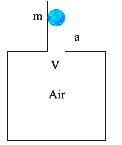Which of the following functions of time represent (a) simple harmonic motion and (b) periodic but not simple harmonic? Give the period for each case.
(1) sinωt−cosωt
(2) sin2ωt Solution in Gujrati
y=sin2ωt=1−cos2ωt2=12−12cos2ωt
This function is periodic but not a simple harmonic, its period.
T=2π2ω
∴T=πω
It represents a harmonic motion with the point of equilibrium occurring at 12 insted of zero.
Topper's Solved these Questions
- OSCILLATIONSBOOK - KUMAR PRAKASHANCHAPTER - OSCILLATIONSEXERCISE - SECTION-B (NUMERICAL FROM TEXTUAL EXERCISE)
48 Videos
- OSCILLATIONSBOOK - KUMAR PRAKASHANCHAPTER - OSCILLATIONSEXERCISE - SECTION-B (ADDITIONAL EXERCISE)
9 Videos
- OSCILLATIONSBOOK - KUMAR PRAKASHANCHAPTER - OSCILLATIONSEXERCISE - SECTION-A (TRY YOURSELF)
64 Videos
- OBJECTIVE QUESTIONS AS PER NEW PAPER STYLE BOOK - KUMAR PRAKASHANCHAPTER - OBJECTIVE QUESTIONS AS PER NEW PAPER STYLE EXERCISE - CHAPTER - 8 (Match Type questions)
5 Videos
- PHYSICAL WORLDBOOK - KUMAR PRAKASHANCHAPTER - PHYSICAL WORLDEXERCISE - SECTION-E (QUESTIONS FROM MODULE)
9 Videos
Similar Questions
Which of the following examples represent periodic motion?
View SolutionAn air chamber of volume V has a neck area of cross section a into which a ball of mass m just fits and can move up and down without any friction (Fig.14.27). Show that when the ball is pressed down a little and released , it executes SHM. Obtain an expression for the time period of oscillations assuming pressure-volume variations of air to be isothermal [see Fig. 14.27].

View SolutionWhat is motion ?
View SolutionType of satellites are given in Column-I and their uses are given in Column-II. Match them properly :
Column-IColumn-II(1) Polar satellite(a) Tele communication(2) Geo-stationary satellite(b) Investigation(c) For information about atmosphere
View Solution.…. state of substance at very high temperature has generated hope of energy source for mankind.
View SolutionWhich of the following functions of time represent (a) simple harmonic motion and (b) periodic but not simple harmonic motion? Give the period for each case. (i) sinomegat-cosomegat (ii) sin^(2)omegat (iii) cosomegat+2sin^(2)omegat
View Solutionसमय के निम्नलिखित फलनों में से कौन (a) सरल आवर्त गति तथा (b) आवर्ती गति को निरूपित करता है परंतु सरल आवर्त गति नहीं ? प्रत्येक का आवर्तकाल निकालिए |
(a) sinωt−cosωt
(b) sin2ωt
View SolutionWhich of the following functions of time represent (a) simple harmonic motion and (b) periodic but not simple harmonic? Give the period for each case.
(1) sinωt−cosωt
(2) sin2ωt
View SolutionWhich of the following functions of time represent (a) simple harmonic motion and (b) periodic but not simple harmonic? Give the period for each case.
(1) sinωt−cosωt
(2) sin2ωt
View SolutionWhich of the following functions of time represent (a) simple harmonic motion and (b) periodic but not simple harmonic motion? Give the period for each case.
(i)sinωt−cosωt (ii) sin2ωt (iii) cosωt+2sin2ωt
View SolutionWhich of the following functions of time represent (a) simple harmonic motion and (b) periodic but not simple harmonic? Give the period for each case. (1) sinomegat-cosomegat (2) sin^(2)omegat
View SolutionWhich of the following functions of time represent (a) simple harmonic motion and (b) periodic but not simple harmonic? Give the period for each case.
(1) sinωt−cosωt
(2) sin2ωt
View SolutionWhich of the following functions of time represent (a) simple harmonic motion and (b) periodic but not simple harmonic? Give the period for each case. (1) sinomegat-cosomegat (2) sin^(2)omegat
View SolutionWhich of the following functions of time represent (a) simple harmonic motion and b. periodic but not simple harmonic? Give the period for each case. (1) sin omega t -cos omega t 2. sin^(2)omega t
View SolutionWhich of the following functions of time represent (a) simple harmonic motion and b. periodic but not simple harmonic? Give the period for each case.
(1) sinωt−cosωt 2. sin2ωt
View SolutionWhich of the following functions of time represent (a) simple harmonic motion and (b) periodic but not simple harmonic motion? Give the period for each case. (i) sinomegat-cosomegat (ii) sin^(2)omegat (iii) cosomegat+2sin^(2)omegat
View Solution
